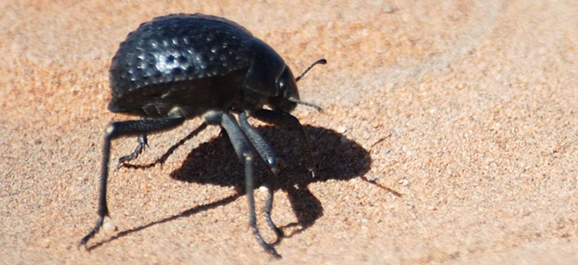Water Bottles That Fill Themselves? Science Wins.
This article is more than 2 years old
It makes me feel old and guilty not being able to remember when bottled water first saturated the marketplace. I can’t even say with conviction whether city water was as terrible beforehand, or if it got markedly worse after people turned away from the tap. But even with a proliferation of different kinds of filters, and various studies showing privatized bottled water to be less regulated than public, government-controlled water, these portable wastes of plastic aren’t going away anytime soon. Realize I don’t think they’re wastes for every reason, just for American reasons.
The key, then, becomes adapting the product for global use — you know, for those places where houses with eight indoor water faucets aren’t available. Enter NBD Nano, a start-up company comprised of four fresh-faced recent college grads eager to adapt the Namib desert beetle’s (pictured below) natural technology to change the world.

Namib beetles have a shell covered with tiny bumps, and as humidity accumulates, water droplets form and roll down the beetles’ backs, collecting in its mount. This is how it survives in a harsh location which only receives about one-half inch of rain a year. Inspiring, yes? I think I drink more water than that just watching someone run on a treadmill.
Though still in early stages, the NBD team’s creation is a bottle with a nano-scale surface, made up of hydrophillic (water-attracting) and hydrophobic (water-repellant) materials, which enhances water condensation wherever the user may be holding it. It is to say, someone can take the empty bottle with them on a hike without ever needing to fill it up from an outside supply. And if this product’s mere existence weren’t exciting enough, the group claims the bottle can collect up to three liters of water per hour. Three liters!
NBD Nano is hard at work creating a functional prototype, and are hoping to work it so that a fan can pass over the surface for that air to be condensed and collected. Their temporary end game is to have the product up for sale in either 2014 or 2015.
“Dry places like the Atacama Desert or Gobi Desert don’t have access to a lot of sources of water,” Galvez said. “So if we’re creating [several] liters per day in a cost-effective manner, you can get this to a community of people in Sub-Saharan Africa and other dry regions of the world. And if you can do it cheaply enough, then you can really create an impact on the local environment.”
It’s one more example in a long line of them proving that inspiration need not come from the farthest recesses of the mind. Sometimes all you have to do is look around, and you’ll find that nature has already invented it for you.











